#Mexico19s: digital transformation before the emergency
DOI:
https://doi.org/10.22201/codeic.16076079e.2019.v20n2.a5Keywords:
earthquake, September 19th, social innovation, citizenship, resilience, crisis, empathy, help, digital culture, digital transformation, mathematical models, inventories, database, social media, algorithmsAbstract
During the Mexico City earthquake in September 19th, digital platforms had a primordial role in sharing information and facilitating help. However, those platforms also contributed to disinformation. In this article we reflect about the use of digital media and digital tools in such circumstances in order to understand the evolutionary moment in which we were then and the one in which we are now in the context of digital transformation and digital culture.
This text is based in the collaboration experience between CoDeck (an interdisciplinary team that integrates data science, social analysis and digital interaction into consultancies) and Huerto Roma Verde (an active community involved in common welfare that coordinates socio-environmental projects). A proposal was implemented in those crucial days after the earthquake; it was based on artificial intelligence with the intention of being actionable as well as a useful tool. The friction between ideas and its implementation in this unique context, consequence of the state of emergency, created dialectical dynamics that are analyzed with the objective of sharing what we learned from them. It is important to stress that all of this was possible in an emergency context where Internet connection and electricity were still working, ...
References
Charney D. (2004). Psychobiological mechanisms of resilience and vulnerability: implications for successful adaptation to extreme stress. Am J Psychiatry.161:195–216.
Chiang, C.L, (2003) Statistical methods of analysis, World Scientific. ISBN981-238-310-7 – page 274 section 9.7.4 “interpolation vs extrapolation”.
Crooks, Andrew y Heppenstall, A. J. (2012). Introduction to Agent-Based Modelling. DOI: 10.1007/978-90-481-8927-4_5.
Gobernanza (s.f.). Temas mundiales. Naciones Unidas. Recuperado de http://www.un.org/es/globalissues/governance/.
Weisstein, Eric W. (s.f.). Traveling Salesman Problem. Wolfram Research. Recuperado de http://mathworld.wolfram.com/TravelingSalesmanProblem.html.
Problema del viajante (s.f.). En Wikipedia. Recuperado de https://es.wikipedia.org/wiki/Problema_del_viajante.
Humberto Maturana y Francisco Varela (2003). De máquinas y seres vivos: autopoieis, la organización de lo vivo. Ed Universitaria Lumen 6ta edición.
Lawler, E., Lenstra, J., Rinnooy Kan, A. y Shmoys, D. (1985). The Traveling Salesman Problem: A Guided Tour of Combinatorial Optimization. Nueva York: Wiley.
Sameera Abar, Georgios K., Theodoropoulos, Pierre Lemarinier, Gregory M. P. O’Hare (2017). Agent Based Modelling and Simulation tools: A review of the state-of-art software, Computer Science Review. Vol. 24. pp. 13-33.
Sean Coughlan (12 de enero de 2017). Qué es la “posverdad”, el concepto que puso de moda el “estilo Trump” en Estados Unidos. BBC Mundo.
Shumway, R. H. y Stoffer, D. S. (2000). Time Series Analysis and Its Applications, with R Examples, 2nd ed. Nueva York: Springer-Verlag.
Waegeman, Willem, De Baets, Bernard y Boullart, Luc (2008). “ROC analysis in ordinal regression learning”. Pattern Recognition Letters. 29: 1-9. DOI: 10.1016/j.patrec.2007.07.019.
Published
Issue
Section
License
Copyright (c) 2020 Revista Digital Universitaria

This work is licensed under a Creative Commons Attribution-NonCommercial-ShareAlike 4.0 International License.

Revista Digital Universitaria es editada por la Universidad Nacional Autónoma de México se distribuye bajo una Licencia Creative Commons Atribución-NoComercial 4.0 Internacional. Basada en una obra en http://revista.unam.mx/.










